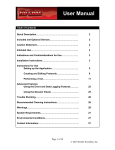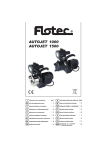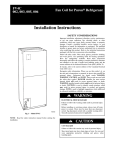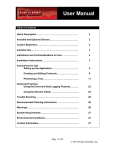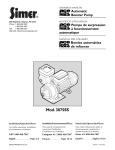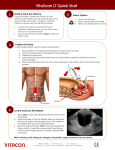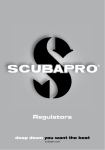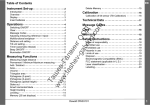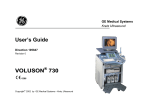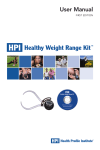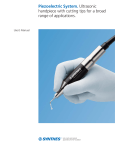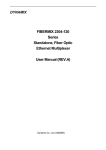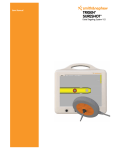Download RADAR™ - Kardia
Transcript
RADAR ™ MODEL 4150 Vascular Compression Device User Manual www.compressar.com RADAR™ User Manual The single-use RadAR Vascular Compression Device is indicated for use by medical professionals to promote hemostasis at a puncture site into a blood vessel in a patient’s arm, following a cannulation procedure. CAUTION: The RadAR Vascular Compression Device must be applied by a physician, nurse or technician experienced with vascular procedures. The patient must be checked regularly for bleeding, hematoma or thrombosis while the RadAR is in use. RadAR should be used only for hemostasis of a puncture site on a patient’s arm. Sterile or aseptic technique should be used. DO NOT LEAVE THE PATIENT UNATTENDED WHILE HEMOSTASIS IS BEING ACHIEVED. • Sterility of package contents is not guaranteed if the individual packages are previously damaged or opened. Only new, sterile RadAR devices taken from factory-sealed pouches should be used. • Do not use alcohol, disinfectants, or any other liquids with the RadAR or on the patient while the RadAR is being applied. RadAR must be deployed onto a dry site. • Federal (USA) law restricts this device to sale by or on the order of a physician. compression pad dial floating pad housing groove cushion pad strap INSTRUCTIONS FOR USE Clinicians should always follow institutional protocols for post-procedure hemostasis when deploying the RadAR device. Positioning RadAR 1 Use sterile or aseptic technique to remove RadAR from pouch. Ensure that the puncture site and area is dry. Place the strap around the patient’s arm, with the housing and compression pad located on the radial side of the wrist. The dial should face up. At the user’s option, a dry sterile gauze pad may be placed between the compression pad and the patient’s skin. 2 Thread and pull the strap tip up through the housing. Position the housing squarely on the side of the wrist and the front part of the compression pad directly over the puncture site. Move the floating pad along the strap so that it is placed over the ulna. The sheath should seat under the groove on the bottom of the compression pad. At this point, the strap should be snug on the patient. Take care not to apply occlusive pressure prior to removing the sheath. Removing the Sheath 3 Check the compression pad to ensure that its front part is directly over the puncture site. Press down firmly over the compression pad with your thumb and begin pulling the sheath with your opposite hand. Increase the pressure over the compression pad with your thumb so there is no bleeding as the sheath is removed. 4 While pressing down firmly on the compression pad, slowly tighten the strap by turning the purple dial clockwise (to the right) so that there is no bleeding from the puncture site. Tighten the dial to obtain occlusive pressure but take care not to apply excessive pressure. Follow institutional protocol for postcatheterization hemostasis. Adjusting Compression 5 It is strongly recommended that immediately after the bleeding has stopped, an initial compression adjustment be made to permit distal blood flow through the radial artery. Slowly turn the dial counterclockwise (to the left) and palpate immediately distal to the compression pad until a radial pulse is detected. In most instances, only an eighth (1/8) to a quarter (1/4) turn is needed. 6 Wipe away any blood from the puncture area and ensure there is no bleeding or oozing from the site. The strap may be tucked under the loop of the compression pad to keep it out of the way. 7 As per your institutional protocol, gradually release compression to increase distal blood flow. It is recommended that compression adjustments be periodically made every 30 minutes by turning the dial counterclockwise (to the left) an eighth (1/8) of a turn. If bleeding or oozing occurs while compression is released, turn the dial clockwise (to the right) to tighten. Removing RadAR 8 Once hemostasis has been achieved and all pressure has been released, prepare to remove RadAR. Gently palpate around the compression pad to assure it is not sticking to the patient’s skin. Turn the dial counterclockwise (to the left) until the strap is loose enough to pull over the patient’s hand. Discard the device per your institutional protocol. 9 An alternative way to remove RadAR is to disengage the purple dial from the threads on the strap located inside the housing. To do this, using your index finger and thumb, grab the neck of the purple dial. Place the tip of your middle finger against the fingertip tab of the housing and firmly pull the dial back. Next, grab the strap with your opposite hand and push it through the housing. Remove the device from the patient and discard per your institutional protocol. Cautions The RadAR device contains no user-repairable parts. Contact your Advanced Vascular Dynamics representative for service and support. The RadAR device, including its packaging, does not contain latex. STERILE EO Sterile symbol. This indicates that the RadAR is sterilized using ethylene oxide. No re-use symbol. This indicates that the RadAR is for single use only and is not intended to be re-used. Instruction symbol. This indicates that you must read the accompanying instructions. RADAR™ LIMITED WARRANTY The Advanced Vascular Dynamics RadAR™ Vascular Compression Devices are warranted against defective material and workmanship for one year following delivery of the product to the original purchaser. If any Device or part thereof, in the judgment of Advanced Vascular Dynamics (AVD), is proven to be defective in material or workmanship during the limited warranty period, such defects will be repaired or component or product replaced (at AVD’s option) free of charge for parts or labor. Any replacement part may be new or refurbished and like-new parts. This limited warranty shall not apply to any product which has not been used in accordance with the manual, been misused, abused, altered or repaired by anyone other than AVD or its authorized representatives. This limited warranty does not cover RadAR Devices which have been reprocessed or re-used in any way. Use of anything other than new RadAR Devices in previously unopened factory sterile packaging immediately and permanently voids all warranties and AVD shall not be liable to any person for any indirect or direct consequential damages resulting from or caused by any defect, failure, or malfunction of such Devices or any component thereof. This limited warranty is in lieu of, and AVD specifically disclaims, all other warranties, express or implied, including any implied warranty of merchantability or fitness for a particular purpose, and AVD shall in no event be liable to any person for indirect, direct, incidental, special or consequential damages of any kind or character. No person is authorized to assume for AVD any other liability in connection with the sale of this Device or its components. Some states or countries do not allow the exclusion or limitation of incidental or consequential damages or allow limitations on how long a limited warranty lasts, so the above limitations or exclusions may not apply to you. This limited warranty gives you specific legal rights, and you may also have other rights that vary from state to state or country to country. To obtain factory service, contact AVD at the address shown on back page of manual, request a Returned Goods Authorization, shipping instructions, and the ship-to address. The RadAR System is to be shipped, freight pre-paid. In-warranty products will be returned to the sender, postage pre-paid. Advanced Vascular Dynamics 1910 NW 23rd Place Portland, Oregon 97210 USA Ph) +1-503-223-2333 Fax) +1-503-223-8585 Toll-Free USA) 1-800-525-2555 www.compressar.com EC REP Niederemserstr 16A, D-65510 Idstein, Germany Tel: +49-6082-910640 Fax: +49-6082-910730 FoxMed GmbH 1910 NW 23rd Place Portland, Oregon 97210 USA Tel: +1-503-223-2333 Fax: +1-503-223-8585 Semler Technologies, Inc. 0470 RADAR ™ Advanced Vascular Dynamics®, AVD™, the logos, PressureMate™, ComfortPress™, CompressAR®, RadAR™, SuperComfort™, and Semler Technologies are trademarks or registered trademarks of Semler Technologies, Inc. Manual number 061-4150-00 rev. A September, 2010 RadAR User Manual RadAR devices are made in the USA. Patents pending. Copyright © 2010 Semler Technologies, Inc. All rights reserved.








